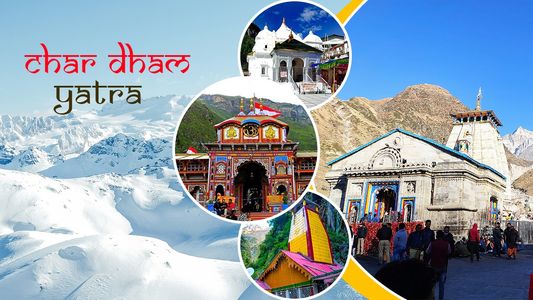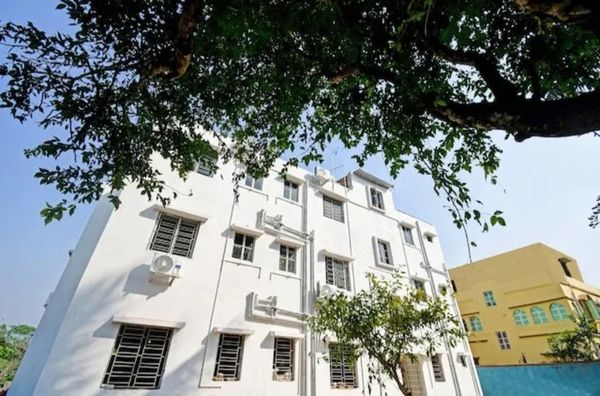How to Plan for Chardham Yatra
 Neha Rawat
10 Jun, 2024
11 mins read
825
Neha Rawat
10 Jun, 2024
11 mins read
825

Char Dham Yatra, encompassing the sacred shrines of Yamunotri, Gangotri, Kedarnath, and Badrinath, is one of the most revered and arduous pilgrimages in Hinduism. This guide aims to provide you with essential information, practical tips, and insights to ensure a smooth and spiritually enriching journey.
Introduction to Char Dham Yatra
As the snow recedes from the Himalayas and the valleys bloom under clear skies, the Garhwal region of Uttarakhand springs to life, welcoming pilgrims from across India. These devout Hindus embark on the Char Dham Yatra, visiting the ancient temples nestled in the high altitudes of the Himalayas. The journey to these four shrines is considered a path to salvation, freeing the soul from the cycle of birth and rebirth.
Significance of Char Dham Yatra
In Hinduism, pilgrimages hold immense spiritual significance. The Char Dham Yatra, comprising visits to Yamunotri, Gangotri, Kedarnath, and Badrinath, is believed to cleanse the soul and offer liberation. According to ancient scriptures, this pilgrimage can lead to moksha, or salvation, liberating the soul from the cycle of birth and rebirth. The journey is not just a physical trek but a spiritual quest for higher consciousness and inner peace.
Legends of the Char Dham Temples
- Yamunotri Temple: Dedicated to Goddess Yamuna, Yamunotri is believed to be the origin of the Yamuna River. Legend has it that a dip in the holy river can prevent untimely death and grant salvation. The temple is also associated with Asit Muni, a sage who is said to have meditated here.
- Gangotri Temple: This temple is tied to the legend of King Bhagirath, who performed penance to bring the Ganges from the heavens to the earth. Bathing in the sacred waters of the Ganges at Gangotri is believed to purify the soul and offer liberation to the departed.
- Kedarnath Temple: One of the 12 Jyotirlingas, Kedarnath is dedicated to Lord Shiva. The temple is believed to have been established by the Pandavas and later reconstructed by Adi Shankaracharya. Its unique triangular Shiva lingam and the legends surrounding it make it a significant pilgrimage site.
- Badrinath Temple: Dedicated to Lord Vishnu, Badrinath is set against the backdrop of the Nar and Narayan mountain ranges. Legends speak of Lord Vishnu meditating here and being shielded from the elements by Goddess Lakshmi, who turned herself into a Badri tree.
Registration for Char Dham Yatra 2024
Registration is mandatory for the Char Dham Yatra. Pilgrims can register online on the official Char Dham Yatra website using a valid email ID and photo identification. Upon registration, a digital pass (E-pass) will be issued, granting permission for darshan at the holy shrines. Registration can also be done at various designated centers such as Rishikesh, Haridwar, and Uttarkashi.
Reaching the Char Dham Temples
Due to the challenging terrain, the Char Dham temples are not directly accessible by rail or air. However, various modes of transportation can be utilized to reach the pilgrimage sites.
- By Road: Most pilgrims start their journey from Haridwar or Rishikesh, known as the gateways to Char Dham. Regular bus services, private taxis, and shared jeeps are available from these cities. Routes are also available from Dehradun.
- By Rail: The nearest railway station to the Char Dham sites is in Haridwar, which is well-connected to major cities across India.
- By Air: The closest airport is Jolly Grant Airport in Dehradun, offering domestic flights from major Indian cities. From the airport, pilgrims can hire taxis or buses to reach the starting points of the yatra.
- By Helicopter: For a more convenient and quicker option, helicopter services are available from the Sahastradhara Helipad in Dehradun. This option is especially suitable for senior citizens and physically challenged individuals. Helicopter tours cover all four temples, providing VIP darshan and comfortable accommodations.
Char Dham Yatra Route
Traditionally, the Char Dham Yatra follows a clockwise route, starting from the west with Yamunotri, followed by Gangotri, Kedarnath, and finally Badrinath.
- Yamunotri: Accessible via a 36 km drive from Barkot followed by a 7 km trek.
- Gangotri: A 100 km drive from Uttarkashi.
- Kedarnath: A 74 km drive from Rudraprayag followed by a 20 km trek.
- Badrinath: A 160 km drive from Rudraprayag.
For helicopter tours, the route typically starts from Dehradun and proceeds to Yamunotri, Gangotri, Kedarnath, and Badrinath.
Best Time to Visit Char Dhams
The Char Dham Yatra typically begins in April/May and concludes in October/November. The best time to undertake the pilgrimage is from late April to early June, before the onset of the monsoon. Monsoon season brings the risk of landslides and floods, making travel hazardous. The post-monsoon months of September and October also offer a good window for the yatra, although temperatures can be quite cold.
Packing and Preparation Tips
Given the high altitudes and unpredictable weather, proper packing and preparation are crucial for a successful yatra.
- Clothing: Pack warm clothing such as jackets, sweaters, thermal inners, and socks. Even in summer, the nights can be cold.
- Weather Protection: Carry raincoats, umbrellas, and water-resistant shoes to deal with sudden weather changes.
- Health and Safety: Bring essential medications, a first aid kit, and a water bottle with a filter. Altitude sickness medication is also recommended.
- Fitness: Prepare physically with regular exercise, including jogging, walking, and stretching. This is particularly important for the treks to Kedarnath and Yamunotri.
- Essentials: Sunglasses, sunscreen, hats, flashlights, power banks, and extra batteries should be part of your packing list.
- Food and Hydration: Carry energy bars, nuts, dry fruits, and chocolates to maintain energy levels. Stay hydrated by drinking plenty of water.
- Documents: Keep copies of your registration, identification, and a recent negative COVID-19 RTPCR test result.
- Footwear: Comfortable and sturdy trekking shoes are essential. Avoid wearing sarees; instead, opt for salwar kameez or track pants for ease of movement.
Safety and Health Precautions
- Physical Fitness: Ensure you are in good health before undertaking the yatra. Those with pre-existing conditions should consult a doctor.
- Travel Insurance: Consider purchasing travel insurance to cover medical emergencies and trip cancellations.
- Weather Awareness: Stay informed about the weather conditions and heed any advisories or warnings.
- Emergency Contacts: Keep a list of emergency contacts, including local authorities and your travel agency.
Frequently Asked Questions
- How Can I Do Char Dham Yatra? The yatra can be done by road or helicopter. For a hassle-free experience, consider booking through a government-approved tour operator.
- Should I Choose a Tour Operator? Yes, booking with a tour operator can ensure better facilities, smoother transfers, and a more comfortable stay. They also assist with registration and provide travel consultants for support.
- Which Dham Should I Visit First? Traditionally, the yatra begins with Yamunotri, followed by Gangotri, Kedarnath, and Badrinath.
- What Is the Cost of Char Dham Yatra? The cost varies depending on the mode of transport and accommodation. A road trip might cost between INR 30,000 to 50,000, while a helicopter tour could cost upwards of INR 1 lakh.
- What Is the Cost of VIP Darshan in Kedarnath? VIP darshan costs INR 2,100.
- What Is the Cost of Helicopter Service from Guptkashi to Kedarnath Helipad? A round trip costs INR 5,000.
- How to Reach Badrinath from Kedarnath by Road? The route covers Kedarnath – Ukhimath – Chopta – Gopeshwar – Chamoli – Pipalkoti – Joshimath – Govindghat – Badrinath, totaling 218 km.
Conclusion
The Char Dham Yatra is a spiritually uplifting journey that requires thorough preparation. By following this comprehensive guide, pilgrims can ensure a safe, comfortable, and fulfilling pilgrimage. Remember to respect the local customs, maintain cleanliness, and carry the spirit of devotion and reverence throughout your journey.
Written By:
Neha Rawat



Hotels at your convenience
Now choose your stay according to your preference. From finding a place for your dream destination or a mere weekend getaway to business accommodations or brief stay, we have got you covered. Explore hotels as per your mood.





